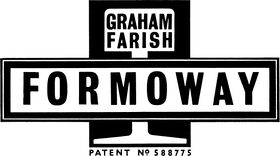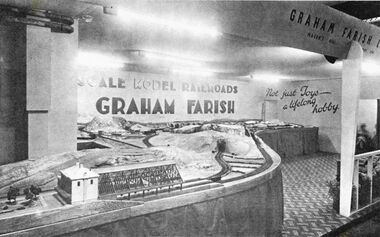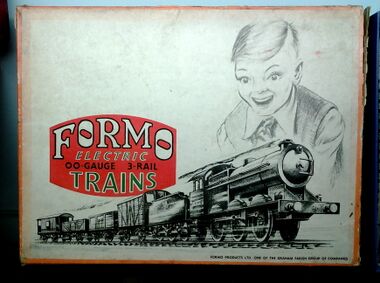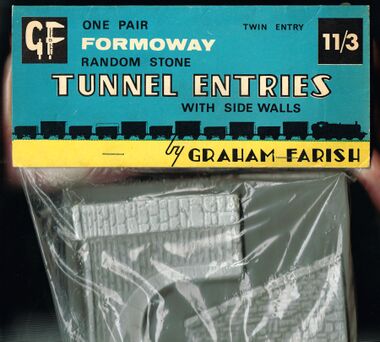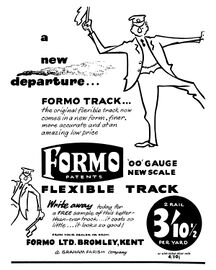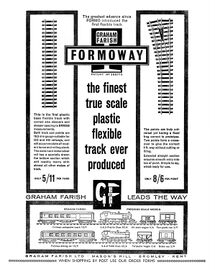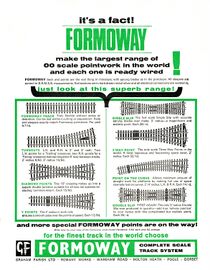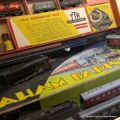Category:Graham Farish
| Toy Brands and Manufacturers |
|---|
Graham Farish |
| 1948 - |
1932: Graham Farish radio components [image info]
Thomas Graham Farish (top left), R.D. ("Dudley") Dimmock, top right, Peter Graham Farish, lower middle-right [image info]
1948: The Graham Farish stand, British Industries Fair [image info]
1948: Launch of the Formo flexible track at the 1948 British Industries Fair [image info]
"Formo Electric 00-gauge 3-rail Trains", box artwork [image info]
The Graham Farish factory building, promotional photo published in 1970 [image info]
Formoway Tunnel-mouth [image info]
Graham Farish (the company) was founded by Thomas Graham Farish in 1919, and made and sold a range of engineering-based "odds and sods", capitalising on the radio craze by selling radio components for home constructors. When the enthusiasm for home-built radios subsided, Graham Farish moved into other manufacturing, and made electric fires, jar lids, fountains and plant food pellets, with Thomas Graham Farish enthusiastically patenting various innovations. They reinvented themselves as a model railway company in 1948.
Always looking for new markets, Graham Farish showed their Formo flexible model railway track in 1948, with their GP5 00-gauge train sets appearing in 1949, and produced sixty-odd figures for the Coronation in 1953. As one of the early adopters of two-rail 00-gauge, Graham Farish then briefly started producing three-rail sets, in 1953, under the Formo name.
The motors for their (two!) model locomotives were scheduled for migration from 3-pole to 5-pole operation in late 1969.
Farish were always a slightly odd model railway brand. While they had something of a cult reputation in some circles for the ability of their locomotives to run realistically at very slow scale speeds (after being suitably run-in), they didn't produce all that many locomotives, or all that many variations on rolling-stock, perhaps hesitant to commit to the necessary tooling-up costs without having the possibility of mass-market sales of their big competitors. A comparatively small operation without a massive toy or model range, or major toy distribution, the main product line that Farish advertised – quite strongly – was the more unglamorous market sector of model railway track and points (which Farish had apparently mastered and invested in, and could presumably churn out at reasonably low cost).
Formoway track and points
Where Farish had a special selling point was their flexible track - a product that sold to enthusiasts who would curve it to shape and cut it to size, and which was more suited to hobby shops than toyshops. Because flexible track assumed more technical know how and tools than simple plug-together track, the main model railway companies tended not to produce it, leaving the market open for small specialist companies like Farish and Peco.
Once you have gained a little experience with your first train set, you will find yourself envying those enthusiasts who own a layout with universal track. Flexible track can be used to form curves or any length, and gives the builder complete freedom as far as track planning is concerned, as one is not restricted to one specific radius.
Graham Farish
The Graham Farish track system is one such universal system, and the track they produce is in three foot lengths which can, or course, be curved to any radius, and cut to any length. A little more skill is required to lay track of this sort, and I shall be dealing with this in greater detail next month. The same firm also produce a number of locomotives and beautiful Pullman coaches.
The range of points produced by Graham Farish is very comprehensive, and includes a double slip, single slip, three way point, diamond crossing, curved point, Y point, 2 ft. radius point, and 3 ft. radius point.
— , -, , Meccano Magazine, , October 1965
First-generation locos
The first-generation 00-gauge locos were a Black Five, a Bulleid Pacific, and a Prairie Tank. The design, construction and materials were a little quirky, and at some point in the late 1950s, Farish seem to have decided to clear out the existing stocks, and start again with new designs. Advertising announcing the selling off of the last of the stock was done under the name of Hutchinson Roe, also of Bromley, Kent, who seem to have been one of the Graham Farish companies.
1960s: Second-generation locos
The second-generation 00-gauge locos were a GWR Pannier Tank loco and a revised Prairie Tank loco.
It's not entirely clear why the company seem to have decided to only make tank locomotives for the relaunched range: perhaps they thought that some customers had been put off by the odd tender-motor-and-universal-coupling arrangement used in their earlier tender loco models, and would be wary of buying new Farish tender locos: or perhaps Farish intended to make a wider range of locos, and never quite got around to it.
Oddly, both tank locos had different dedicated electric motors and chassis, so it's not as if the decision was meant to re-use technical R&D and parts, to make production more efficient.
1970: N gauge
Like fellow track manufacturer Peco, the fact that Farish hadn't invested massively strongly in a super-wide product range for 00-gauge (in the 1960s they only seemed to have two basic loco designs) meant that when the new N-gauge format appeared, they were able to throw themselves into the new format, launching their N-gauge range in 1970, and dropping the 00-gauge range entirely in the early 1980's to concentrate exclusively on N-gauge.
The brand became part of Bachmann Industries in 2000.
Advertising
Addresses
- Graham Farish Group Sales Limited – Romany Works, Wareham Rd., Holton Heath, Poole, Dorset – (1970)
Patents
Thomas Graham Farish:
- GB563797A Improvements in and relating to glass-houses and the like, 1943-04-23 / 1944-08-30 (worldwide.espacenet.com)
- GB571196A Improvements in electric switches, 1943-12-24 / 1945-08-10 (worldwide.espacenet.com)
- GB576696A Improvements in electric plug and socket connectors, 1944-03-30 / 1946-04-16 (worldwide.espacenet.com)
- GB583153A Improvements in electric clocks, 1944-10-11 / 1946-12-10 (worldwide.espacenet.com)
- GB586345A Improvements in electric clocks, 1944-12-11 / 1947-03-14 (worldwide.espacenet.com)
- GB588775A Improvements in and relating to tracks for miniature or toy railways, tramways and the like, 1945-03-05 / 1947-06-03 (worldwide.espacenet.com)
- GB590068A Improvements in closures for jars and like containers, 1944-08-17 / 1947-07-08 (worldwide.espacenet.com)
- GB592724A Improvements in electric fires, 1945-05-25 / 1947-09-26 (worldwide.espacenet.com)
- GB598582A Improvements in the construction of electromagnets, 1945-08-17 / 1948-02-20 (worldwide.espacenet.com)
- GB646246A Improvements in fastening devices, 1948-06-30 / 1950-11-15 (worldwide.espacenet.com)
- GB674868A Improvements in or relating to direct current electric motors particularly for driving toys or small models, 1949-01-13 / 1952-07-02 (worldwide.espacenet.com)
- GB680917A Improvements in vehicles, 1949-11-30 / 1952-10-15 (worldwide.espacenet.com)
- GB693387A Toy, 1950-12-15 / 1953-07-01 (worldwide.espacenet.com)
- GB714114A Improvements in or relating to guards for electric fires or like heating devices, 1952-06-09 / 1954-08-25 (worldwide.espacenet.com)
- GB1021258A Improvements in or relating to a method of rendering boats or aircraft capable of reflecting radar waves, 1961-11-03 / 1966-03-02 (worldwide.espacenet.com)
- GB1105751A Improvements in and relating to boat-shelter combinations, 1966-03-23 / 1968-03-13 (worldwide.espacenet.com)
- GB1285507A Couplings for model vehicles, 1970-08-28 / 1972-08-16 (worldwide.espacenet.com)
- GB1376503A Model railways points, 1973-01-23 / 1974-12-04 (worldwide.espacenet.com)
External links
Subcategories
This category has the following 2 subcategories, out of 2 total.
0
- Graham Farish 00 gauge (2 P, 15 F)
N
- Graham Farish N gauge (20 F)
Pages in category ‘Graham Farish’
The following 2 pages are in this category, out of 2 total.
Media in category ‘Graham Farish’
The following 47 files are in this category, out of 47 total.
- Area 43.jpg 1,024 × 1,024; 619 KB
- BIF 1948, Graham Farish stand (GF 1964).jpg 3,000 × 2,290; 1.31 MB
- Bolster Wagon, Graham Farish N gauge (GFN 1970).jpg 1,215 × 819; 79 KB
- Brake Van WR, Graham Farish N gauge (GFN 1970).jpg 1,540 × 913; 147 KB
- Brake Van, 00-gauge, Graham Farish (GF 1964).jpg 1,382 × 1,003; 189 KB
- Cattle Van, Graham Farish N gauge (GFN 1970).jpg 1,227 × 963; 124 KB
- Coaches tba, 00-gauge, Graham Farish (GF ~1965).jpg 2,862 × 3,000; 617 KB
- Container Chassis, Graham Farish N gauge (GFN 1970).jpg 1,187 × 674; 61 KB
- Container, Graham Farish N gauge (GFN 1970).jpg 1,028 × 1,016; 114 KB
- Fast Goods Van, 00-gauge, Graham Farish (GF 1964).jpg 1,459 × 1,048; 193 KB
- Fish Van, Graham Farish N gauge (GFN 1970).jpg 1,202 × 911; 140 KB
- Five Plank Open Wagon, Graham Farish N gauge (GFN 1970).jpg 1,203 × 791; 119 KB
- Flat Tar Truck, Graham Farish N gauge (GFN 1970).jpg 1,212 × 818; 102 KB
- Formo box artwork, Graham Farish.jpg 1,740 × 1,296; 736 KB
- Formo Ltd, Graham Farish (MRN 1959-12).jpg 2,400 × 3,000; 560 KB
- Formoway complete track system, Graham Farish (MM 1965-10).jpg 2,374 × 3,000; 1.31 MB
- Formoway Flexible Track, Graham Farish (RM 1962-12).jpg 2,389 × 3,000; 1.14 MB
- Formoway logo, Graham Farish (1963).jpg 2,194 × 1,219; 152 KB
- Formoway points, Graham Farish (GF ~1965).jpg 3,000 × 2,064; 1.05 MB
- Formoway Track System, Graham Farish (MM 1965-12).jpg 2,337 × 3,000; 1.2 MB
- Formoway Tunnel Mouth packaging, Graham Farish.jpg 1,800 × 1,621; 493 KB
- Graham Farish Catalogue, cover (GF 1964).jpg 3,000 × 2,232; 856 KB
- Graham Farish Clearance, Hutchinson Roe (MRN 1959-12).jpg 922 × 1,200; 206 KB
- Graham Farish radio components (HW 1932-12-10).jpg 2,000 × 1,300; 493 KB
- Graham Farish stand, British Industries Fair 1948 (GF 1964).jpg 3,000 × 1,871; 1.07 MB
- Graham Farish stockists, double-page (MRN 1970-11).jpg 3,000 × 1,920; 1.08 MB
- GWR Pannier in N Gauge (GFN 1970).jpg 3,000 × 2,171; 558 KB
- GWR Pannier Tank loco, 00-gauge, Graham Farish (GF 1964).jpg 2,905 × 1,833; 598 KB
- GWR Prairie Tank loco, 00-gauge (GF 1964).jpg 2,885 × 1,865; 624 KB
- Horse Box, Graham Farish N gauge (GFN 1970).jpg 1,216 × 937; 140 KB
- Just like the real thing, Graham Farish N gauge (MRN 1970-11).jpg 2,391 × 3,000; 1.16 MB
- Liveway track for N gauge, Graham Farish (GFN 1970).jpg 3,000 × 2,042; 639 KB
- Mineral Open Wagon, Graham Farish N gauge (GFN 1970).jpg 1,244 × 857; 114 KB
- N-gauge Scale Models Handbook, Graham Farish, cover (GFN 1970).jpg 3,000 × 2,164; 866 KB
- Pannier Chassis, Graham Farish (GF 1964).jpg 2,811 × 1,319; 386 KB
- Personalities, Graham Farish (GF ~1965).jpg 3,000 × 2,077; 667 KB
- Prairie Chassis, Graham Farish (GF 1964).jpg 2,844 × 1,240; 341 KB
- Pullman Composite Coach, 00-gauge, Graham Farish (GF 1964).jpg 2,425 × 1,159; 343 KB
- Pullman Dining Car, 00-gauge, Graham Farish (GF 1964).jpg 2,431 × 1,158; 349 KB
- Seven Plank Open Wagon, Graham Farish N gauge (GFN 1970).jpg 1,244 × 838; 124 KB
- Single Vent 12T Box Van, Graham Farish N gauge (GFN 1970).jpg 1,248 × 965; 161 KB
- Steel Wagon, 00-gauge, Graham Farish (GF 1964).jpg 1,327 × 920; 139 KB
- Tarpaulin Open Wagon, Graham Farish N gauge (GFN 1970).jpg 1,226 × 840; 122 KB
- Tarpaulin Wagon, 00-gauge, Graham Farish (GF 1964).jpg 1,337 × 994; 145 KB
- The Graham Farish factory building (GFN 1970).jpg 3,000 × 1,831; 1.04 MB
- Three Plank Open Wagon, Graham Farish N gauge (GFN 1970).jpg 1,222 × 779; 99 KB
- Twin Vent 12T Box Van, Graham Farish N gauge (GFN 1970).jpg 1,221 × 954; 146 KB
